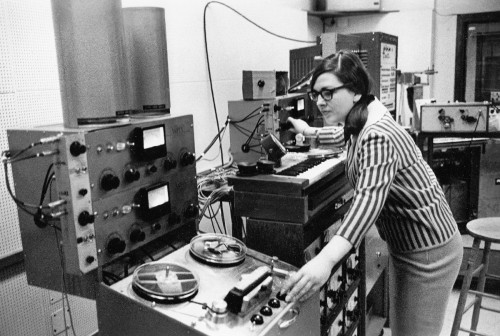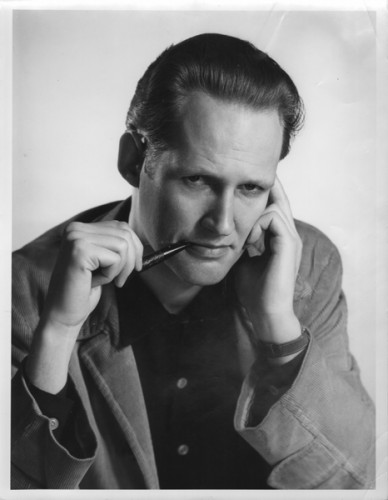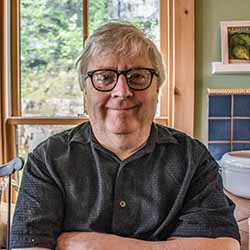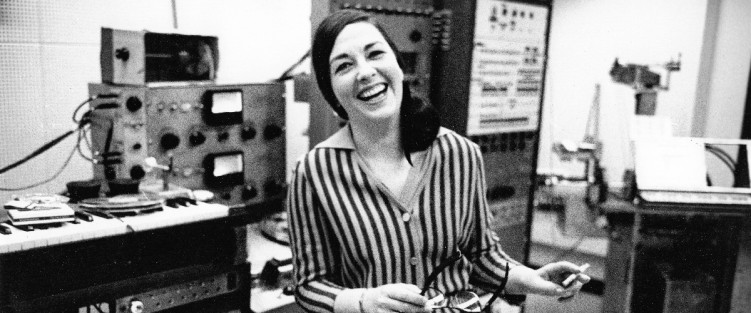Canadian composer Norma Beecroft (b. 1934) recently released her book, Conversations with Post World War II Pioneers of Electronic Music, containing an insightful and revealing collection of interviews that explore the history of electronic music around the world. The book, originally published as an e-book, contains transcriptions of her interviews with many of the principal innovators who shaped electronic music from its earliest days. Beecroft, of course, is herself one of the pioneers of electronic music.
Her creative life closely mirrors the appearance and development of what was, in the mid-20th century, the newest musical medium. Given that she was also a prolific broadcaster and a maker of radio documentaries about contemporary composers of her day, it should be no surprise that she decided, in 1977, to embark on this landmark series of interviews with her fellow electronic music pioneers.
The list of the composers included in Beecroft’s book is comprehensive, reading like a who’s who of early electronic music. Among the 23 interviews, prominent names such as Luciano Berio, John Cage, Pierre Schaeffer, Karlheinz Stockhausen and Iannis Xenakis jump out of the group. Max Matthews, the so-called “father of computer music” is there. And there are important Canadian innovators as well, such as Bill Buxton, Gustav Ciamaga, James Montgomery and Barry Truax. Each interview is framed with a carefully drawn profile of her subject, intricately and accurately placing each into historical context.
The 400-plus-page book also contains an extensive preface, in which Beecroft introduces the overall subject of the relationship between music and technology, which is broadly relevant to her topic. She also details highlights of her own career, creating historical markers in the process, that show her creative work in parallel with her interview subjects. She describes herself as, “the second of five offspring of a father who was an inventor, Julian Beecroft (1907–2007) and one of his main interests was acoustics and sound, which he began investigating when he was very young.” She touches on her early composition lessons with John Weinzweig (1913–2006), interspersed with her other career activities, including her work with CBC Television in the 1950s, a time when TV was the newest of the broadcast media. It was also a period of her life when she travelled extensively, to both the United States and to Europe, meeting numerous composers, conductors and performers in the process. These acquaintances helped her in the development of the many phases of her career: composer, broadcaster and arts administrator (this latter role as co-director – with Robert Aitken – of Toronto’s New Music Concerts, from 1971 to 1989). And a great many of these colleagues found their way into her collection of interviews.
Beecroft writes: “It was inevitable that I would join those questioning the present and future value of this new technology to music, this fascinating interaction between the fields of science and the humanities. And so, in 1977, I began my investigations into exploring music’s relationship to technology through the voices of some of the world’s foremost creative musical minds.” She concludes her preface with the notion: “It is generally agreed that the field of electronic music began in Paris, France, in the studios of the French Radio, then experiments in this new domain were being conducted at Columbia University in New York, and at the West German Radio in Cologne. Accordingly, I have ordered my collection of interviews in the same manner, beginning in France, and then moving to the United States and Germany, then followed with important work by Luciano Berio (1925–2003) and Bruno Maderna (1920–1973) at the Italian Radio in Milan, and concluding this volume with the interviews in Canada.” At the same time, she notes: “All these activities were mushrooming around the same period of time, in the years immediately following World War II, so the order is essentially inconsequential.”

Beecroft began organizing her enterprise in 1977, in a series of letters to her intended subjects in Europe. She told me she was confident in positive responses from the composers since she was known to them, and that they trusted her knowledge of the subject. She was by this time acknowledged not only as a composer, but as a highly skilled broadcaster, and she had easy access to all her subjects. She told me that Iannis Xenakis (1922–2001), for example, said: “One thing I like about you is your determination.” Her travels took her first to Cologne, Berlin, Köthen, then Paris, London, and Utrecht. Additional interviews were scheduled in the United States, and back home in her Toronto studio, when possible.
The results of all these interviews were highly rewarding, and revealed great amounts of both historical and personal details. Beecroft’s subjects opened up to her highly focused line of questioning, delving into the recent past, to a time when they were all drawn to the artistic and technical challenges of this new musical medium. In the very first interview, for example, with Pierre Schaeffer (1910–1995), inventor of the concept of musique concrète using recorded sounds, and who founded Le Club d’Essai in 1942 and the Groupe de Recherche Musicales in 1958 in Paris, it’s immediately clear that Schaeffer’s focus is primarily on research and engineering. He refers to clashes in methodology with Pierre Boulez (1925–2016), Karlheinz Stockhausen (1928–2007) and Iannis Xenakis, and confesses: “I hate dodecaphonic music, and I often say that the Austrians shot music with 12 bullets, they killed it for a long time.” This was a somewhat surprising revelation for me, but is typical of the sort of candid views Beecroft’s colleagues were willing to share with her.
In the Stockhausen interview, by contrast, we find the other side of the argument. “In Paris I became involved in the musique concrète that was at that time just beginning to develop. Boulez made me listen to a very few, very short studies, and immediately I was interested in trying myself to synthesize sound, and to get away from the treatment of recorded sound.” Stockhausen went on to mention his collaboration with Belgian composer Karel Goeyvaerts, who had suggested a technique of combining pure sine waves to synthesize timbres: “I have to say that the friendship with this Belgian composer, and the exchange of letters with him, was a very important reason why I made these first experiments, because we were both thinking that it would be a marvellous thing if we could synthesize timbres. The general idea of timbre composition was in the air from texts of Schoenberg.”
Goeyvaerts recalled in his interview: “I never thought that pure sine waves could be heard. And suddenly I found that they existed with an electronic generator, so I wrote to Stockhausen and said, now we can go ahead.” He added: “When Stockhausen made the Study No. 1 and when I made my piece in 1953, I must say we considered at last we could come to a pure structure.” It was also in this year that the term “electronic music” was coined by Dr. Herbert Eimert (1897–1972) at the studio of the Cologne Radio.
Historical turning points such as these appear often throughout Beecroft’s Conversations with Post World War II Pioneers of Electronic Music. But as important as such details are, the personal notes of the composers are possibly the more interesting aspect. An example is in the interview with American composer Otto Luening (1900–1996), who studied with composer and virtuoso pianist, Ferruccio Busoni (1866–1924), and was friends with composer Edgard Varèse (1883–1965). Luening said, of Busoni: “The essence of music, the inner core of music was to him still a mystery and he was like Schopenhauer in that, who I believe said somewhere if we knew the mystery and relationships of music, we would know the mystery and relationships of the whole universe.” And of Varèse, Luening said: “We immediately hit it off. Not only did I have great affection for him, and liked him very much personally, but we had this Busoni tie.” He mentioned the various stylistic groups of American composers current and pointed out: “Varèse and I were on this other line, we were really free wheelers, you know, and while we had a very strong aesthetic, it was not organized, there was no movement or anything, and we never wanted one. We used to talk together and so gradually we fell into a group of friends, that were very interesting and all kind of iconoclasts.”
These personal snapshots were entirely a part of Beecroft’s focus and plan for her project. In a letter to Stockhausen after the first edits were finished, she told him: “The publication is not intended to be a scholarly document on technical matters but an insight into the internal world of the composer and sociological forces that helped shape the person.” She projected to him that, “I am sure this modest document will help fill a void when it comes to musical matters in the latter half of this century.” The book is available through the Canadian Music Centre, 20 St. Joseph Street, Toronto, and can also be ordered online. The details can be found here: musiccentre.ca/node/155113.

Norma Beecroft continues to compose. Montreal composer-pianist Bruce Mather invited her to create a work for his Carrillo piano, an instrument with 96 notes to the octave, which is to say, it’s tuned in 16ths of tones. Beecroft’s new composition will have its world premiere on March 11 at 7:30 at the Salle de concert of the Conservatoire de musique de Montreal, 4750 avenue Henri-Julien. It’s a work for solo Carrillo piano with digital soundtracks. Beecroft wrote: “Written for my friend and colleague Bruce Mather, this piece posed challenges that I could not resist. Having worked in analogue studios for most of my career, I determined to try my hand at composing using digital software only. The Carrillo piano was another challenge, as the entire piano keyboard consists of only one octave of sound. Training my ears to hear the microtones was a new problem, as was a system of notation for the performer. Herewith – my modest attempt at combining the two elements!” She explains further that the work’s design, “finds its analogy in nature, with the opening and closing of a flower. The one octave is divided in half and opens up slowly to create ever-widening intervals. And the flower slowly ends its fragile existence in a retrograde movement.”

Also in Montreal in March, a special dramatic concert presentation titled “Between Composers: Correspondence of Norma Beecroft and Harry Somers, 1955–1960” will take place at the Tanna Schulich Hall of McGill University on March 22 at 7:30pm. Composer and McGill music professor Brian Cherney conceived the presentation, and he describes the idea:
“From 1955 until early in 1960, Norma Beecroft and Harry Somers were involved in a romantic relationship. In the fall of 1959, Norma went to Rome to study composition with Goffredo Petrassi. While there, she also studied flute with Severino Gazzelloni, the renowned flutist for whom many composers such as Berio wrote important new works for flute. During the last months of 1959 and early 1960, Somers and Beecroft exchanged nearly 200 letters, providing considerable information about their evolving relationship, what music they were writing, various compositional concerns, and the people they were meeting (in Toronto and in Rome). As well, Norma Beecroft’s letters describe her struggle to gain the confidence to study composition but also to finally reject a permanent ‘domestic’ relationship with Harry Somers, in other words, to devote herself entirely to composition. Thus the letters give us a fairly detailed portrait of that period in Canadian composition (of concert music): their compositional concerns, problems of financial support, thoughts about the state of the arts in Canada, and so on.
“In the concert being presented at McGill University on March 22, I have chosen significant excerpts from these letters and these will be read by two people, interspersed with music by each of the composers, chiefly, the String Quartet No.3 (1959) by Somers, dedicated to Norma Beecroft, and the film Saguenay, for which Somers wrote the music in early 1960 (and described in detail in the letters) and the Amplified String Quartet with Tape by Beecroft, written in the 1990s.”
Norma Beecroft will take part in both these Montreal events.
Returning briefly to the topic of the history of electronic music, I’m happy to announce that on March 8, a 1977 vintage recording by the Canadian Electronic Ensemble (CEE) will be released on the Artoffact record label. The CEE is a performing ensemble that I helped to establish in the early 1970s, and which continues to function even now, nearly 50 years later. This vintage re-release is a remastered version of the debut album by the CEE, originally released on an LP on the Music Gallery Editions label. By coincidence, the music contained on the album was all composed and performed at roughly the same period of time as Beecroft was travelling the world recording her interviews. The CEE’s founding quartet of David Grimes, the late Larry Lake, David Jaeger (aka me) and James Montgomery are the performers, together with a guest appearance by the late pianist Karen Kieser. The album is available as both a CD and in digital formats on Bandcamp: thecee.bandcamp.com.

David Jaeger is a composer, producer and broadcaster based in Toronto.
